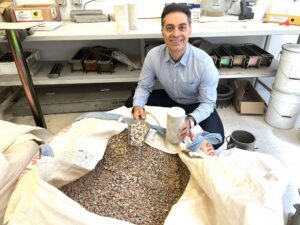
The use of recycled concrete and glass aggregates in concrete production has emerged as a highly promising means of increasing the recycling rate of waste materials – but durability issues have plagued some combinations of recycled ingredients.
Now, researchers from Flinders University and other international institutions have developed a high-performance and sustainable concrete formula that can resist alkali-silica reaction (ASR), which has a negative impact on mechanical properties and durability of concrete due to the significant silica content of some recycled aggregates.
The researchers focused on a blend of ground granulated blast furnace slag (GGBS) and fly ash (a by-product of coal combustion in power stations) as binder materials to mitigate negative ASR effects on the mechanical properties and durability of concrete made with crushed glass sand and coarse recycled concrete aggregate (RCA).
The results found that the GGBS component is less effective than the fly ash in reducing the ASR expansion of the concrete.
It also showed that combining 20% GGBS with 30% fly ash in recycled aggregate concrete containing glass sand develops similar compressive and flexural strengths and water absorption compared to that containing natural sand.
However, they found that increasing GGBS content leads to a decrease in the strengths and an increase in the water absorption of the concrete.

“The results of this study point to the significant potential of combining fly ash and GGBS at an optimum ratio to mitigate the ASR effect on recycled aggregate concrete containing crushed glass sand,” says Dr Aliakbar Gholampour, an expert in the development of sustainable construction materials, from the College of Science and Engineering of Flinders University.
“The developed technology can be used in different applications where natural sand or gravel are currently being used, such as road construction, landscaping and infrastructure projects.
“By integrating these recycled materials into construction and manufacturing practices, industries can contribute to a more sustainable built environment and circular economy.
“This approach helps minimise the emission of greenhouse gases and other pollutants generated during cement production, thereby mitigating environmental pollution.
“Additionally, it helps preserve natural resources by reducing the depletion of natural sand and coarse aggregate.”
The research also found that:
- The full replacement of natural sand with glass sand leads to a significant ASR expansion of mortar bars. Replacing 30% of cement with fly ash leads to an 88% decrease in the expansion rate of the bar. The GGBS is less effective in reducing this expansion, with only a 3%, 9%, and 12% decrease in the expansion by adding 20%, 40%, and 70% GGBS to the concrete containing 30% fly ash, respectively.
- Replacing natural sand with glass sand causes a 37% and 20% decrease in compressive and flexural strengths of concrete, respectively. However, incorporating 30% fly ash leads to an 18% and 10% increase in the strengths of the ASR-affected RCA concrete with glass sand, respectively. It is notable that combining 20% GGBS with 30% fly ash develops similar strengths to RCA concrete with natural sand.
- ASR-affected RCA concrete with glass sand exhibits a 67% higher water absorption than concrete made with natural sand. Combining 30% fly ash with 20% GGBS causes similar water absorption to concrete with natural sand. However, further increase in GGBS content leads to an increase in water absorption.
- Incorporating 20% GGBS leads to a significant increase in the chloride attack resistance of ASR-affected RCA concrete that contains glass sand. An increase in the GGBS content from 20% to 70% causes a 27% increase in the chloride ion penetration of the concrete.
The research – “Concrete containing recycled concrete coarse aggregate and crushed glass sand: Mitigating the effect of alkali-silica reaction,” by Aliakbar Gholampour, Armin Memarzadeh, Mahdi Nematzadeh, Mohammad Valizadeh Kiamahalleh, Tuan D. Ngo – has been published in Structural Concrete journal. doi.org/10.1002/suco.202301029






